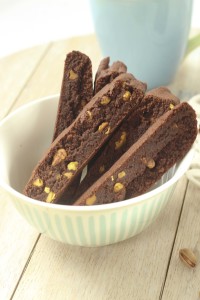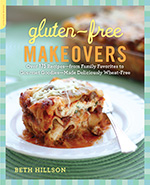From Beth Hillson
When I was diagnosed with celiac disease in 1976, I lived in Europe. Glorious food was everywhere, but I didn’t know what I could and couldn’t eat. Sure, I stayed away from the obvious like brioche, croissant and pizza. (It brings tears to my eyes to think about all the goodies I missed.) But the subtle hidden sources of gluten were a problem and for that I went to culinary school – Cordon Bleu and Dieppe Cooking School for starters – to better understand the important components of baking and cooking. Along with learning important questions to ask (Is the fish dusted in flour? Is the sauce thickened?), I also learned to bake flaky crusts and brioche that, of course, I couldn’t eat.
Being a pioneering woman, I started to make over those recipes, maintaining the ratios but replacing the flour with rice flour and cornstarch, the only two ingredients I had in my pantry at the time. The results were decent enough to keep me returning to my mixing bowls. But I knew there was room for improvement – sometimes those crusts were more crumbly than flaky and rolls often bounced or served as doorstops. I shudder to think of how many gluten free sandwiches have fallen apart in my hands depositing mayonnaise, cold cuts and chunks of dry bread in my lap.
I knew I had a long way to go to replicate those rich baked goods that Chef La Court had taught us to make in France. But I was willing to try. After all, I reaped the benefits!
Admittedly, my Gluten-Free Pantry (GFP) mixes were light years ahead of anything else available in the eighties and nineties – revolutionary, almost. They provided many, many celiac patients with delicious homemade breads, muffins, brownies and such, and raised the standard we came to expect of our gluten free baked goods.
Since creating GFP in 1993, each iteration of gluten free baking has come closer to perfect. Don’t get me wrong. I’ve consumed my share of gritty, crumbly and dry food in my quest for excellent products. I’ve also tasted some amazing food along the way.
So, when RYZE Gluten Free asked me to try their new products (think, baking blends), I didn’t know what to expect – more gritty muffins and cookies or a product that might raise the bar once again.
I tried their flour in my favorite biscotti recipe – chocolate pistachio biscotti, a recipe I know is already great. It seemed like that would be a good benchmark, a great way to compare something new with something tried and true.
I replaced my complicated flour blend with an equal amount of RYZE flour. Yup, just one ingredient (well, actually two- whole grain brown rice and white rice), no gums, no starches. Without starches and gums, RYZE also has a better nutritional profile than most flour blends.
I wondered how RYZE would stand up to a pantry-full of flours. I mixed up the recipe and formed it into a log. Then I popped it into the oven for the first baking. Here comes the tricky part. Gluten free biscotti is difficult to cut. I always lose some slices to breakage and crumbling. I cooled the log, transferred it to a cutting board and began to slice. The first slice came away whole – no breakage; no crumbled edges. The second was the same. I was able to cut the third, fourth, and fifth without losing a single slice. Hmmm. Pretty amazing.
When I finished cutting the biscotti, I baked them again, cooled them and stored them. I brought some to my sister who is also a gluten free baker. The biscotti recipe is really hers. Her first question was, what did you do to keep them from crumbling?
I knew then that I was on to something– something revolutionary.
I’ve since made focaccia, biscuits, cookies and much more. All are moist, light and have a delicate crumb. I’ll share more recipes another time. For now, I have to say that RYZE Gluten Free raises the bar … and lucky for all of us gluten free bakers.
Here’s my recipe to Chocolate Pistachio Biscotti and a picture of the RYZE packages.
Chocolate Pistachio Biscotti
Makes 20 Biscotti
I’ve made the biscotti with pistachios and with hazelnuts. Both are equally tasty.
1 ½ cups RYZE Blue Blend
¾ cup unsweetened cocoa powder
1 teaspoon baking powder
½ teaspoon baking soda
1/4 teaspoon salt
½ cup unsalted butter (1 stick) softened
1 cup sugar
2 large eggs
1 teaspoon pure vanilla extract
¾ cup shelled pistachios or chopped toasted hazelnuts
Preheat the oven to 350 degrees F. Line a shallow baking sheet with parchment paper.
Whisk together the dry ingredients: RYZE Blend, cocoa powder, baking powder, baking soda, and salt.
In a medium bowl, beat the butter with the sugar until light and fluffy (about 3 minutes).
Add the eggs and vanilla to the butter mixture and beat until blended. Add the dry ingredients and beat until incorporated.
Fold in the nuts. Knead mixture with your hands until smooth and nuts are well incorporated.
On prepared baking sheet, form the mixture into a log that is about 16 inches long and about 5 inches wide.
Bake 30 minutes. Remove from the oven to cool for 10 minutes. Maintain the oven temperature.
When cool enough to touch, gently transfer the log to a cutting board. Cut into about 20 slices of even thickness. Turn the biscotti on their sides on the baking sheet and bake 20 minutes.
Cool and store in an airtight container for several days or in the freezer for up to 3 months.
RYZE has two formulas – blue and yellow. Both are simply whole grain brown rice and white rice – no gums, no starches. They are designed for specific types of baking, spelled out on each package. The web site, just launched, has lots more recipes to try. In addition, you’ll have good luck replacing your flour blend with one of the RYZE blends in a 1 to 1 replacement for all your favorite recipes. RYZE products will be available at Amazon.com beginning in May.
Categories: Recipes | Tags: gluten free baking, gluten-free recipes, RYZE Gluten Free | 1 Comment »








 Baking guru,
Baking guru,
Jenny says:
January 23, 2017 at 10:35 pm /
Thank you